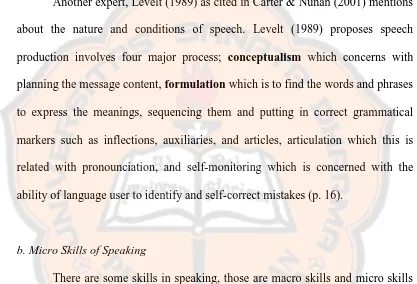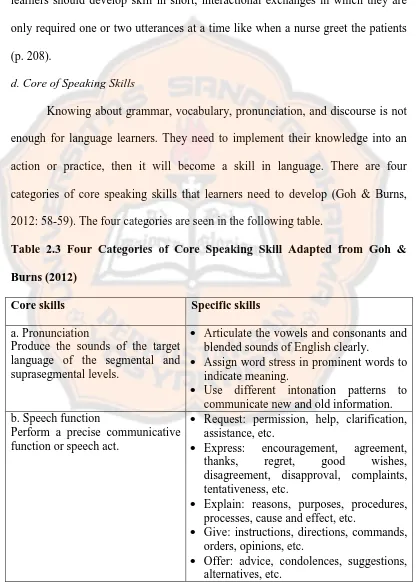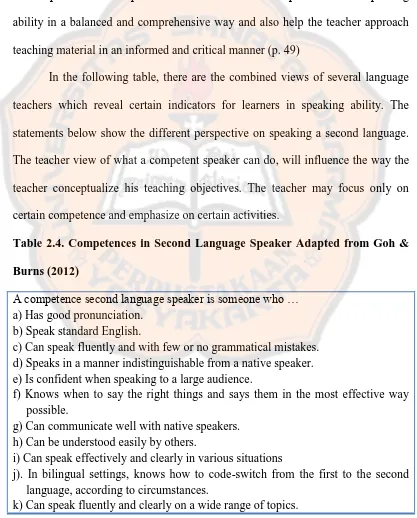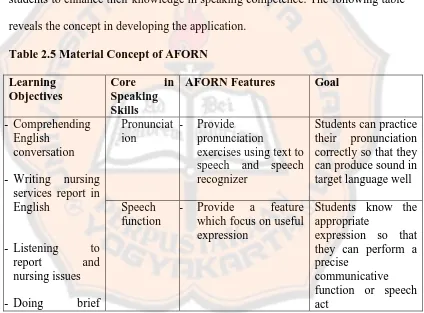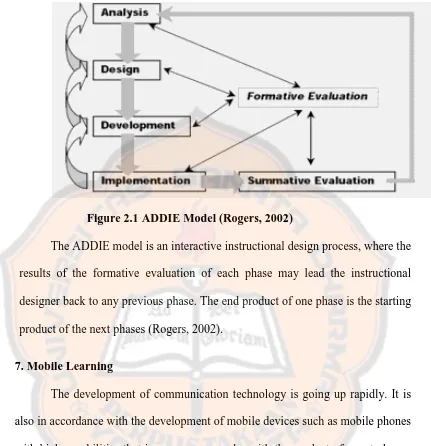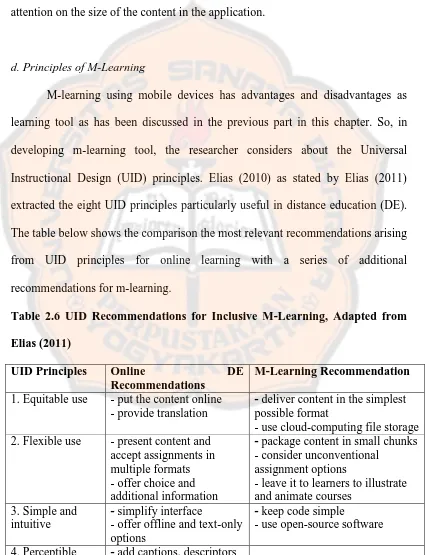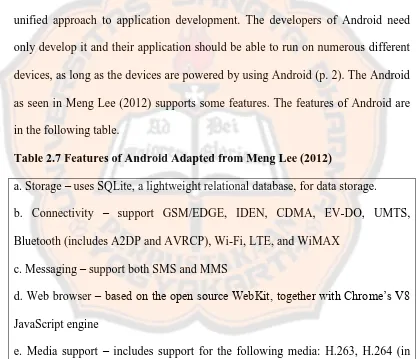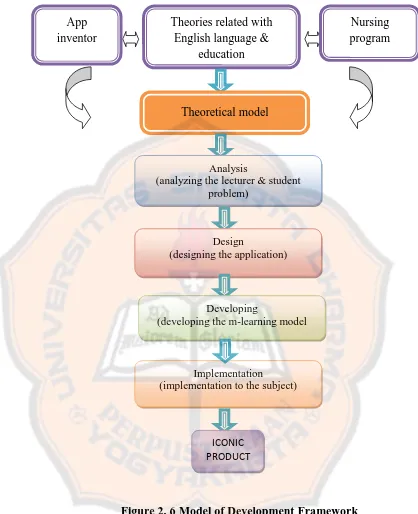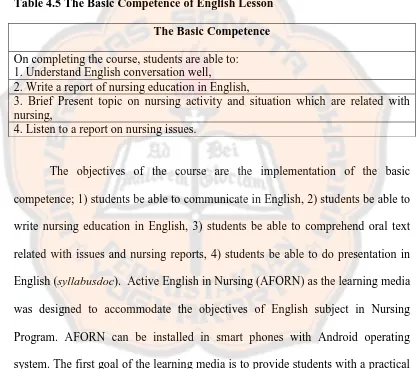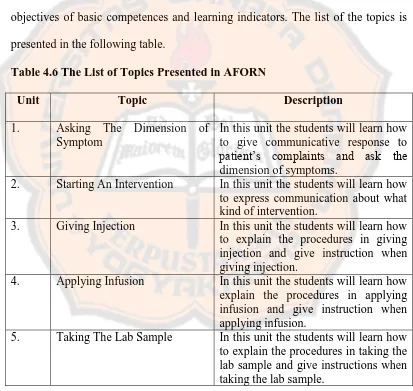ABSTRACT
Rochmawati, Desi. 2015. Active English for Nursing (AFORN): An M-Learning Model to Enhance Nursing Students’ Speaking Skill. Yogyakarta: Graduate Program on English Language Studies, Sanata Dharma University.
Speaking skill is one of four language skills in English. For doing good communication in educational or professional situation, the ability in speaking is important because ability in speaking English well is the priority for many second
language learners. People evaluate one’s success in language learning through the
ability to speak up. In Nursing Program in Poltekkes Yogyakarta, the students are supposed to be able to communicate in English that then it will help the students in academic affair and professionalism. In fact, the nursing students are very busy with their tight schedule for other subjects. They only have small opportunities in learning English, in the classroom. Active English for Nursing (AFORN) was
developed to accommodate the students’ need. AFORN is a learning media for
learning English speaking which can be installed in any mobile phones with Android Os. This research was aimed at discovering the functionality of the
learning media which are able to enhance students’ speaking skill. There were two
research problems which were discussed in this study; 1) What does the iconic model of AFORN (m-learning model to enhance speaking skill for nursing students) look like? 2) How does AFORN enhance the speaking skill of the nursing students?
This research focused on designing AFORN. In this study, the researcher employed mix-method of ADDIE (Analysis, Design, Development, Implementation, Evalution) model and R & D (Research and Development) process in developing the learning media, AFORN. There were 5 lesson units in the AFORN, each unit contained activities and exercises based on the topic. The research was conducted in Nursing Program of Poltekkes Yogyakarta. The target population was 44 nursing students of Regular Class in semester four in academic year 2014/2015. The data were taken in three steps; need analysis step, preliminary field testing step, main field testing step. The data were collected by distributing questionnaire and doing interview. In collecting the data for preliminary field testing and main field testing, the researcher installed the
AFORN in the respondents’ smart phones or tablets. The respondents were the nursing students, English Lecturers, and IT experts, They then gave their opinion, comments, and suggestion to the learning media, AFORN. The feedbacks from the respondents were used as the basic for conducting revision on the product.
ABSTRAK
Rochmawati, Desi. 2015. Active English for Nursing (AFORN): An M-Learning
Model to Enhance Nursing Students’ Speaking Skill. Yogyakarta: Program Pasca Sarjana Kajian Bahasa Inggris, Universitas Sanata Dharma.
Kemampuan berbicara adalah salah satu dari empat skill dalam bahasa Inggris. Untuk bisa beekomunikasi berbahasa Inggris dalam konteks pendidikan dan profesionalisme, kemampuan berbicara merupakan hal yang penting karena berbicara yang baik dan benar dalam bahasa Inggris merupakan prioritas bagi semua yang sedang belajar bahasa. Orang menganggap bahwa seseorang berhasil dalam belajar bahasa dilihat dari kemampuan berbicaranya. Di jurusan keperawatan Poltekkes Yogyakarta, mahasiswa dituntut untuk mampu berkomunikasi menggunakan bahasa Inggris yang nantinya membantu mahasiswa untuk hal terkait pembelajaran dan profesionalisme kelak. Akan tetapi, mahasiswa keperawatan di Poltekkes Yogyakarta sangat sibuk dengan jadwal kuliah mereka yang padat. Mereka hanya memiliki waktu yang singkat untuk belejar bahasa Inggris, yakni di ruang kelas. Active English for Nursing (AFORN), dikembangkan untuk mengakomodasi kebutuhan mahasiswa tersebut. AFORN adalah media pembelajaran untuk berlatih berbicara yang dapat diinstal di semua hand phone yang menggunakan system Android. Penelitian ini bertujuan untuk menemukan fungsionalitas dari AFORN yang sesuai untuk meningkatkan kemampuan berbicara bagi mahasiswa. Dalam penelitian ini, ada dua permasalahan yakni 1) Seperti apakah model ikonik dari AFORN (model m-learning untuk meningkatkan kemampuan berbicara bagi mahasiswa keperawatan)? 2) Bagaimana AFORN mampu meningkatkan kemampuan bahasa Inggris mahasiswa keperawatan?
Penelitian ini fokus pada pembuatan produk AFORN. Dalam penelitian ini, peneliti menerapkan metode gabungan yakni ADDIE model dan R & D proses dalam mengembangkan media pembelajaran ini. Ada 5 unit pembelajaran dalam AFORN, masing-masing unit dilengkapi dengan kegiatan dan latihan berdasarkan topic setiap unitnya. Penelitian ini dilaksanakan di jurusan keperawatan Poltekkes Yogyakarta. Populasi target dalam penelitian ini adalah 44 mahasiswa keperawatan kelas Reguler semester 4 tahun ajaran 2014/2015. Data diperoleh melalui 3 langkah; analisa kebutuhan, uji lapangan tahap 1 dan uji lapangan tahap 2. Data diperoleh dengan menyebarkan kuesioner dan interview. Dalam memperoleh data pada uji lapangan tahap 1 dan tahap 2, peneliti menginstalkan AFORN pada smart phone atau tablet milik para responden. Para responden adalah mahasiswa keperawatan, dosen bahasa Inggris, dan ahli IT. Kemudian mereka memberikan pendapat, komentar, dan saran pada media pembelajaran, AFORN. Umpan balik dari para responden digunakan sebagai dasar untuk perbaikan produk tersebut.
ACTIVE ENGLISH FOR NURSING (AFORN): AN M-LEARNING
MODEL TO ENHANCE NURSING STUDENTS’
SPEAKING SKILL
A THESIS
Presented as Partial Fulfillment of the Requirements for the Degree of Magister Humaniora (M.Hum)
in English Language Studies
by
Desi Rochmawati Student Number: 136332015
THE GRADUATE PROGRAM IN ENGLISH LANGUAGE STUDIES SANATA DHARMA UNIVERSITY
i
ACTIVE ENGLISH FOR NURSING (AFORN): AN M-LEARNING MODEL TO ENHANCE NURSING STUDENTS’
SPEAKING SKILL
A THESIS
Presented as Partial Fulfillment of the Requirements for the Degree of Magister Humaniora (M.Hum)
in English Language Studies
by
Desi Rochmawati Student Number: 136332015
THE GRADUATE PROGRAM IN ENGLISH LANGUAGE STUDIES SANATA DHARMA UNIVERSITY
iv
I dedicate my thesis to
My beloved husband Ngesti Mulat P., my
dearest son Brilliant Alif Hakeem,
vii
ACKNOWLEDGMENTS
It will be a wonderful opportunity for me to express my deepest gratitude to many people around me who have given support, love, care, suggestion, and prayer for me at anytime. I really thank all of them but I apologize if I cannot mention them one by one.
First of all, my greatest gratitude is addressed to Allah SWT for the blessings, guidance, and for always listening to my prayers and making my wish come true. Alhamdulillah, finally I can complete my thesis.
My deep gratitude is aimed to my thesis advisor, Dr. B.B. Dwijatmoko, M.A. for his advice, suggestion, guidance, patience, and careful correction during the completion of my thesis. Thank you very much for encouraging and motivating me so that I can complete my thesis on time. I would also like to thank F.X. Mukarto, Ph.D., Jaslin Ikhsan, Ph.D., and Dr. J. Bismoko for reviewing my thesis and giving me very useful feedback for the betterment of my thesis. My deepest gratitude also goes to Dr.Ir. Gatot Hari Priowirjanto (Director of SEAMOLEC), SEAMOLEC team, and SEAMOLEC friends for the scholarship and the support for the development of digital learning media in education. Thank you so much for giving opportunity to have a very grateful internship program in SEAMOLEC learning center when I have learnt so much in computer technology.
viii
whom I give my special thanks to Ika, David, Vendi, Shanti, Belinda, and Mbak Marga. You are all more than friends, but you are all my family. Thank you very much for sharing a wonderful moment during our study and the internship program in SEAMOLEC learning center. My deepest gratitude also goes to Oki Wicaksono who was really helpful for me in developing the AFORN. Thank you very much for teaching and guiding whenever I confused about the Blocks in MIT App Inventor. I would also thank my classmates that I can not mention them one by one; Mbak Tanti, Mbak Ana, Bundo (Wulan), Pipit, Mb Hening, Mimi, Levyn, Mb Yunita, etc, thank you very for the discussion during my study. Special thanks to Mbak Lely and friends for their countless service and help during my study.
I would also thank and give my best appreciation to all big family of Politeknik Kesehatan (Kementerian Kesehatan) Yogyakarta for their support and prayers for me. I would thank Tri Prabowo, SKP, M. Sc as the Head of Nursing Department and Rosa Delima Ekwantini, SKP, M.Kes. as the Head of Study Program (D III) for their help, support, and giving me opportunity to have a research in Nursing Program. In addition, my gratitude goes to Mas Suryo and Andika for helping me handle Language Lab. Unit during my study.
Last but not least, I would give my deepest love and gratitude for my little family, to my biggest fan Ngesti Mulat Purwosunu, I thank him for his prayers, never ending love, support and protection for me as always. Brilliant Alif Hakeem, my beloved son, thank you for inspiring me and giving me spirit for all of my life. My life is only for you and may Allah bless us, always.
ix
TABLE OF CONTENTS
TITLE PAGE... i
APPROVAL PAGE... ii
DEFENSE APPROVAL PAGE... iii
DEDICATION PAGE... iv
STATEMENT OF ORIGINALITY... v
LEMBAR PERNYATAAN PERSETUJUAN PUBLIKASI... vi
ACKNOWLEDGEMENTS... vii
TABLE OF CONTENTS... ix
LIST OF TABLES... xii
LIST OF FIGURES... xiii
LIST OF APPENDICES... xiv
ABSTRACT... xv
ABSTRAK... xvi
CHAPTER I. INTRODUCTION... 1
A. Background of the Study... 1
B.Problem Identification... 5
C.Problem Limitation... 7
D.Research Questions... 8
E. Research Objectives... 9
F. Product Specification ……….. 9
G.Research Benefits... 10
CHAPTER II. LITERATURE REVIEW... 13
A.Theoretical Review ………... 13
1. English for Specific Purpose... 13
2.Nursing Program…... 16
3. English Speaking Skill………...……….. 18
a. The Nature of Speaking…………... 18
b. Micro Skills of Speaking……... 19
c. The Importance of Speaking English…………... 20
d. Core of Speaking Skills……….. 22
e. Input in Second Language Acquisition ………. 23
x
B. Review of Related Studies... 52
C. Theoretical Framework…... 55
CHAPTER III. METHODOLOGY... 62
A.Research Method... 62
B.The Research Setting and Participants ……… 67
C.Research Data ………. 68
1. Strategy in Collecting and Organizing Data……… 69
2. Data Collection Technique ………. 71
D.Research Instruments ……….. 72
1. Questionnaire ……….. 72
2. Interview ………. 74
E. Data Analysis…... 75
CHAPTER IV. RESULTS AND DISCUSSIONS... 79
A.Process of Designing the Learning Model... 79
1. Need Analysis………... 79
a. Syllabus Investigation in Nursing Department……… 80
b. The Interview Result……… 81
c. The Questionnaire Result on Students’ Need……….. 85
d. The Finding in Need Analysis………. 90
2. Design………... 92
a. Stating General Objectives, Basic Competence, Topic……… 92
b. Specifying The Learning Indicators………. 95
3. Development………... 97
a. Preliminary Form of Product Development………. 98
b. Preliminary Field testing………. 102
1) Descriptive Statistics of respondents’ Opinions on the Prototype Learning Media………. 103
2) The respondents’ Comments and Suggestion on the Learning Media………. 109
c. Main Product Revision ……… 111
4. Implementation…………... 113
xi
B.The Presentation of the Iconic Model ………... 119
1. Unit Presentation……... 120
2. Activities presentation... 126
C. The Role of AFORN in Enhancing Speaking Skill………..……… 133
1. The Advantages of Using the Learning Model ………...… 134
2. The Weaknesses of the Learning Model ……… 138
CHAPTER V. CONCLUSION... 140
A.Conclusions... 140
B.Suggestions... 142
BIBLIOGRAPHY ... ... 144
xii
LIST OF TABLES
Table Page
2.1. The Goal of English Subject in Nursing Department Adapted from
Syllabus for English Subject ... 15
2.2. Micro Skills of Oral Communication (Brown, 2000)... 19
2.3. Four Categories of Core Speaking Skill (Goh & Burns, 2012)... 22
2.4. Competences in Second Language Speaker (Goh & Burns, 2012)... 24
2.5. Material Concept of AFORN ... 27
2.6. UID Recommendation for Inclusive M-Learning (Elias, 2011)... 35
2.7. Features of Android (Meng Lee, 2012)... 45
3.1. The Stages, Data, Participants, and Instruments... 71
3.2. The Result of The Need Analysis Questionnaire... 76
3.3. The Description of The Evaluation of The Designed Material... 76
3.4. The Conversion Table of The Raw Scores into Converted Score... 77
3.5. The Interpretation of The Degree of Agreement (Best, 1970)... 77
4.1. The Working Concept of Need Analysis Questionnaire... 85
4.2. The Students’ Need and Opportunity in Learning English... 86
4.3. The Use of Technology in Learning Media... 87
4.4. Language Skills and Components... 89
4.5. The Basic Competence of English Lesson... 93
4.6. The List of Topics Presented in AFORN... 94
4.7. Topics Basic Competence, and Learning Indicators... 95
4.8. UID Principles As The Basis of Choosing Learning Activities... 98
4.9. Description of Preliminary Field Testing of Product Respondents... 102
4. 10.Meaning of Point Agreement... 103
4. 11.Conversion Table of The Raw Scores into the Converted Scores... 104
4. 12.The Descriptive Statistics of English Lecturers’ Opinion... 104
4.13. The Interpretation of The Degree of Agreement (Best, 1970)... 106
4.14. The Descriptive Statistics of IT Experts’ Opinion……….…… 107
4.15. The Interpreted Questionnaire Result……… 115
xiii
LIST OF FIGURES
Figure Page
2.1. ADDIE Model (Rogers, 2002)………... 31
2.2. The Design of A Screen in AFORN Seen in MIT App Inventor …… 47
2.3. The Blocks of A Screen in AFORN Seen in MIT App Inventor …… 48
2.4. Ubiquitus Mobile Learning Architecture (Cabanban, 2013)... 49
2.5. The AFORN………... 52
2.6. Model of Development Framework………... 57
2.6. AFORN Application Map... 59
3.1. The Research Design with the Combination between R & D and ADDIE... 66
4.1. The Notification of Problem in MIT App Inventor ……… 112
4.2. The Home Page... 120
4.3. The Lesson Unit ……….. 120
4.4. The Unit 1... 121
4.5. The Unit 2... 122
4.6. The Unit 3... 123
4.7. The Unit 4………... 124
4.8. The Unit 5………. 125
4.9. The Review on Nursing Equipments……… 126
4.10. The Activities in AFORN... 127
4.11. Vocabulary Activity... 128
4.12. The Useful Expression Activity... 129
4.13. The Jumbled Words Exercise………. 130
4.14. The Listening Practice……… 130
4.15. The Group Assessment……….. 130
4.16. The Pronunciation Drill Exercise………... 131
4.17. The Column of Entering Data……… 132
4.18. The Record Data……… 132
4.19. The Forum Zone………. 133
xiv
LIST OF APPENDICES
Appendix Page
Appendix 1. The Working Concept of Need Analysis Questionnaire... 148
Appendix 2. Need Analysis Questionnaire... 150
Appendix 3. The Working Concept of Need Analysis Interview with English Lecturer……….…………. 154
Appendix 4. Transcript of Need Analysis Interview with English Lecturer... 155
Appendix 5. The Construct Mapping of Need Analysis Interview for Student... 157
Appendix 6. Transcript of Need Analysis Interview with Student…... 158
Appendix 7. The Application Map………... 160
Appendix 8. The Working Concept of Preliminary Field Testing... 161
Appendix 9. Questionnaire for English Lecturer... 163
Appendix 10. Questionnaire for IT Expert... 167
Appendix 11. The Result of Expert Validation Questionnaire (English Lecturer)... 171
Appendix 12. The Result of Expert Validation Questionnaire (IT Expert)……… 173
Appendix 13. Transcript of Preliminary Field Testing Interview (English Lecturer) ……….…... 175
Appendix 14. Transcript of Preliminary Field Testing Interview (Nursing Lecturer) ……….... 176
Appendix 15. Transcript of Preliminary Field Testing Interview (IT Practitioner) ………..…... 177
Appendix 16. The Working Concept of Main Field Testing Questionnaire……… 179
Appendix 17. Questionnaire of Main Field Testing………. 181
Appendix 18. The Result of Main Field Testing on User ….……….. 185
Appendix 19. The Result of Main Field Testing Questionnaire…………... 188
Appendix 20. The Result of Preliminary Field Testing Questionnaire ...… 197
Appendix 21. Transcript of Main Field Testing Interview ………... 199
xv
ABSTRACT
Rochmawati, Desi. 2015. Active English for Nursing (AFORN): An M-Learning Model to Enhance Nursing Students’ Speaking Skill. Yogyakarta: Graduate Program on English Language Studies, Sanata Dharma University.
Speaking skill is one of four language skills in English. For doing good communication in educational or professional situation, the ability in speaking is important because ability in speaking English well is the priority for many second language learners. People evaluate one’s success in language learning through the ability to speak up. In Nursing Program in Poltekkes Yogyakarta, the students are supposed to be able to communicate in English that then it will help the students in academic affair and professionalism. In fact, the nursing students are very busy with their tight schedule for other subjects. They only have small opportunities in learning English, in the classroom. Active English for Nursing (AFORN) was developed to accommodate the students’ need. AFORN is a learning media for learning English speaking which can be installed in any mobile phones with Android Os. This research was aimed at discovering the functionality of the learning media which are able to enhance students’ speaking skill. There were two research problems which were discussed in this study; 1) What does the iconic model of AFORN (m-learning model to enhance speaking skill for nursing students) look like? 2) How does AFORN enhance the speaking skill of the nursing students?
This research focused on designing AFORN. In this study, the researcher employed mix-method of ADDIE (Analysis, Design, Development, Implementation, Evalution) model and R & D (Research and Development) process in developing the learning media, AFORN. There were 5 lesson units in the AFORN, each unit contained activities and exercises based on the topic. The research was conducted in Nursing Program of Poltekkes Yogyakarta. The target population was 44 nursing students of Regular Class in semester four in academic year 2014/2015. The data were taken in three steps; need analysis step, preliminary field testing step, main field testing step. The data were collected by distributing questionnaire and doing interview. In collecting the data for preliminary field testing and main field testing, the researcher installed the AFORN in the respondents’ smart phones or tablets. The respondents were the nursing students, English Lecturers, and IT experts, They then gave their opinion, comments, and suggestion to the learning media, AFORN. The feedbacks from the respondents were used as the basic for conducting revision on the product.
xvi
ABSTRAK
Rochmawati, Desi. 2015. Active English for Nursing (AFORN): An M-Learning Model to Enhance Nursing Students’ Speaking Skill. Yogyakarta: Program Pasca Sarjana Kajian Bahasa Inggris, Universitas Sanata Dharma.
Kemampuan berbicara adalah salah satu dari empat skill dalam bahasa Inggris. Untuk bisa beekomunikasi berbahasa Inggris dalam konteks pendidikan dan profesionalisme, kemampuan berbicara merupakan hal yang penting karena berbicara yang baik dan benar dalam bahasa Inggris merupakan prioritas bagi semua yang sedang belajar bahasa. Orang menganggap bahwa seseorang berhasil dalam belajar bahasa dilihat dari kemampuan berbicaranya. Di jurusan keperawatan Poltekkes Yogyakarta, mahasiswa dituntut untuk mampu berkomunikasi menggunakan bahasa Inggris yang nantinya membantu mahasiswa untuk hal terkait pembelajaran dan profesionalisme kelak. Akan tetapi, mahasiswa keperawatan di Poltekkes Yogyakarta sangat sibuk dengan jadwal kuliah mereka yang padat. Mereka hanya memiliki waktu yang singkat untuk belejar bahasa Inggris, yakni di ruang kelas. Active English for Nursing (AFORN), dikembangkan untuk mengakomodasi kebutuhan mahasiswa tersebut. AFORN adalah media pembelajaran untuk berlatih berbicara yang dapat diinstal di semua hand phone yang menggunakan system Android. Penelitian ini bertujuan untuk menemukan fungsionalitas dari AFORN yang sesuai untuk meningkatkan kemampuan berbicara bagi mahasiswa. Dalam penelitian ini, ada dua permasalahan yakni 1) Seperti apakah model ikonik dari AFORN (model m-learning untuk meningkatkan kemampuan berbicara bagi mahasiswa keperawatan)? 2) Bagaimana AFORN mampu meningkatkan kemampuan bahasa Inggris mahasiswa keperawatan?
Penelitian ini fokus pada pembuatan produk AFORN. Dalam penelitian ini, peneliti menerapkan metode gabungan yakni ADDIE model dan R & D proses dalam mengembangkan media pembelajaran ini. Ada 5 unit pembelajaran dalam AFORN, masing-masing unit dilengkapi dengan kegiatan dan latihan berdasarkan topic setiap unitnya. Penelitian ini dilaksanakan di jurusan keperawatan Poltekkes Yogyakarta. Populasi target dalam penelitian ini adalah 44 mahasiswa keperawatan kelas Reguler semester 4 tahun ajaran 2014/2015. Data diperoleh melalui 3 langkah; analisa kebutuhan, uji lapangan tahap 1 dan uji lapangan tahap 2. Data diperoleh dengan menyebarkan kuesioner dan interview. Dalam memperoleh data pada uji lapangan tahap 1 dan tahap 2, peneliti menginstalkan AFORN pada smart phone atau tablet milik para responden. Para responden adalah mahasiswa keperawatan, dosen bahasa Inggris, dan ahli IT. Kemudian mereka memberikan pendapat, komentar, dan saran pada media pembelajaran, AFORN. Umpan balik dari para responden digunakan sebagai dasar untuk perbaikan produk tersebut.
xvii
1 CHAPTER I
INTRODUCTION
A. BACKGROUND OF THE STUDY
Information and Communication Technology (ICT) has developed rapidly around the world. ICT has been implemented in almost every sector for human beings. ICT helps the transmission of knowledge because it accommodates the combination of ideas and technology. ICT takes part in the development of education. One of ICT roles is in language learning, therefore we know CALL and MALL. CALL is Computer Assisted Language Learning which deals with the use of computer technology in language learning, whereas MALL (Mobile Assisted Language Learning) deals with the use of mobile technology in language learning. Kukulska-Hulme & Traxler (2005) state that mobile learning concerned with learner mobility, in the sense that learner should be able to connect with learning activities without any constraints to do those activities related with physical location. It makes possibility and also motivates the learner to have learning activities outside classroom or in various locations. Previously, the opportunities in learning outside classroom might arise books, electronic sources, places and people. But recently, mobile learning is more reachable since the use of portable and lightweight devices such as smart phones and tablets (p.1). This is the reason why the researcher focuses on the use of MALL in this study.
2
English would not be restricted in a classroom only, but the process of teaching and learning can still be administered anywhere and anytime. The process of accepting knowledge would be simpler and easier. The students are able to have learning process anytime and anywhere since the knowledge of English or English materials are delivered by implementing ICT on it. The process of transferring knowledge would be very interesting and surely will be different from the conventional ways that the teaching-learning process should be conducted in a classroom where the teacher and students could see each other. When one of the aspects of learning doesn‟t exist, the transfer of knowledge might not be happened
in the conventional way.
In Health Polytechnic of Yogyakarta (Politeknik Kesehatan/Poltekkes Yogyakarta), the students are supposed to have English proficiency especially in productive skill either written or spoken (syllabus doc). As the researcher knows that most of the students of Poltekkes are still passive in English but nevertheless to fulfill their professional needs, they should be able to communicate using international language. These because for the academic needs, the students will need references such as operational procedures, books, journals, or other sources which mostly are written in English. Further, when the students have become professionals, they might have foreigner patients, for examples tourists or maybe in the future they work in international hospital so that it will be possibly for them as healthcare practitioner to use English for communicating with the patients.
3
and knowing how to produce and understand different types of texts (Richards, 2006: 3). In health areas particularly for nurse or nursing students, communicative competence which mainly focuses on productive language or speaking ability is the main goal of learning English. They should be able to produce spoken language. They will use English for making a report, doing interview or conversation with patients, telling procedure, and some other activities related with their professionalism as health practitioners.
The English competence which is mostly demanded in nursing program is language competence related with productive skill, that is speaking skill. It is because speaking skill is very important for communication. Speaking skill is used in many different purposes and different situations. As seen in Richards & Renandya (2002:201), they state “A large percentage of the world‟s language
4
Recently, our government via Ministry of Health and National Agency for Placement and Protection of Indonesian Migrant Workers or BNP2TKI (Badan Nasional Penempatan dan Perlindungan Tenaga Kerja Indonesia) holds G to G program (Government to Government program) to send healthcare practitioners especially nurse and midwife to Japan and Timor Leste or other countries (bnp2tki.go.id). This is one reason why English communicative skill, especially ability in speaking English is important for students of Poltekkes. They need to learn English for active communication to be able to join the G to G program. Further, in 2015, there will be Asean Economic Challenge (AEC) which possibly transfers human resources such as nurse, teachers, architects and other profession from abroad to Indonesia (kemenperin.go.id). So, the human resources market will be more competitive then. Indonesian nursing must be able to compete with nurse from other country. They must have extra skill as the point plus for their professionalism. One of the skills is ability to communicate using international language to support their professionalism.
5
schedules in laboratory or field practical in certain hospital. In the other hand, the nursing students are demanded to have ability in speaking using international language to support their professionalism. This is one factor which persuades the researcher to create a mobile English learning tool for nursing students which can be accessed by the students anytime and anywhere.
As information and communication technology grow rapidly, the most recent operating system for gadget is Android. Most gadgets use Android for their operating system (Android OS). Android is an open source mobile operating system that has been supported by Google Corporation, the world leading search engine company. The pervasive adoption of android in the mobile market is that mobile applications developed using android technology is more efficient and effective compared with other technologies, such as Window or Symbian operating systems. Android operating system is producing fast, user friendly and appealing application (Hanafi, 2012: vol.3 no.3). In the android smartphones or tablets people can download many applications from Google play store such as games, social medias, tools, musics, books, etc. But, most people only use this kind of gadget for entertainment. The researcher, therefore, wants to utilize this gadget with android operating system as a media to transfer English materials in the form of Active English for Nursing (AFORN) – an m-learning model to enhance nursing students‟ speaking skill.
B. PROBLEM IDENTIFICATION
6
of health polytechnic (Politeknik Kesehatan Yogyakarta/Poltekkes Yogyakarta) especially students of Nursing Program. Since the English curriculum for Nursing Program at Poltekkes Yogyakarta implement English for Specific Purpose (ESP), this learning model is created in the form of android application which contains various materials and exercises related with English proficiency for health practitioner, especially for nursing students. The English material will be specified into communicative skill focusing on speaking skills. The English material found in the m-learning model, AFORN which is installed in mobile phone with Android as the operating system could be a kind of reachable learning model which can be accessed anytime and anywhere.
Students of a three year diploma program in Poltekkes Yogyakarta especially in Nursing Department are the busiest students among students from other departments. They are very busy with their practical schedules from other subjects which are related in health sciences. They have English lesson only once a week in two semesters (semester 3 and semester 4). They are supposed to be able to communicate in English both oral and written. They need more practice in English, not only in the classroom where they have English lesson, but they are supposed to be able to get access to English materials anytime and anywhere. Since they are so busy with their practical schedules for other subjects, they nearly have no time to learn and practice English. To help the students get closer to English lesson, there must be a kind of learning media as a supporting tool for learning English which is accessible and attractive.
7
lecturers have gadgets with Android Os. The researcher finds the gadgets very beneficial as a tool for language learning. So, the researcher designs a kind of supporting tool which can be installed in any gadgets (smart phones or tablets) with Android Os. The students need learning tool which has portability and connectivity (Miangah & Nezaret, 2012). The learning media is m-learning model in the form of android application, called Active English for Nursing (AFORN). By using the AFORN, the students will be helped in learning English everywhere and every time in addition to classroom activity because learning English in classroom situation as in schedule is not effective for practice.
C. PROBLEM LIMITATION
The research is only focus on researching and developing an m-learning model in the form of Android application called AFORN (Active English for Nursing) as a supporting tool or media to improve the speaking skills of nursing students. So, in this research, there is no other method (experimental study) to identify the effectiveness of the application because in order to know the effectiveness of the application, the researcher conducted data gathering by sharing questionnaire and doing deep interview with the students.
8
unit is completed with materials, activities or exercises related with each topic presented in the application. So, when the students do not feel satisfied with the English lesson given in the classroom, they can still get the access to English lesson through their android smart phones or tablets. By doing so, learning English while practicing is possibly done in every time and wherever they are without any limitation. The process if learning will also be more interesting.
The reason why Android application is chosen as the platform in developing the learning model is intimately associated with the terms specified by SEAMOLEC as the sponsor. SEAMOLEC requires all the students sponsored by SEAMOLEC to conduct a research on Android application as a learning model. The population used in the sampling of this research is also limited to the semester IV students of a three year diploma program in nursing, Nursing Department of Poltekkes Yogyakarta.
D. RESEARCH QUESTIONS
There some problem formulations which are going to be discussed. The problems are focused on the form and implementation of m-learning model in the form of Android application to enhance nursing students‟ speaking skill:
1. What does the iconic model of AFORN (m-learning model to enhance speaking skill for nursing students) look like?
9 E. RESEARCH OBJECTIVES
The objectives of the study are to answer the questions presented in the research questions. First, the this research aims to present the final version of Active English for Nursing (AFORN), an m-learning model in the form of Android application which can be installed in mobile phones with Android as the operating system (Android Os). The m-learning model was developed especially for nursing students to enhance their English competence, especially speaking skill. In this study, the researcher employed the instructional design using ADDIE model (Rodgers, 2002) which will be combined with R&D cycle (Borg & Gall, 1983).
The second goal of this study is to identify how the AFORN help the nursing students enhance their speaking skill in accordance with the goal of English lesson in Nursing department which is aiming at improving their speaking skill.
F. PRODUCT SPECIFICATION
10
The application, AFORN will be used as supporting tool for language learning. It means that as a supporting tool, AFORN is not the main learning media for speaking practice. AFORN is an alternative learning tool which can be used outside the classroom by the nursing students even though it still can be used as learning tool in the classroom situation. The students have already get English lesson in the classroom once a week then for further learning process, they can use the application which has already been installed in their smart phones or tablets to have more practices through some features provided in the application. AFORN is very possibly to be used at anytime and anywhere.
The advantages of using AFORN as a learning tool; First, students can still have English exposure and access English lesson which focus on speaking skill at anytime and anywhere even in the middle of their hectic schedules, for example; while waiting for the turn to practice in a laboratory, they can learn English from the application installed in their gadgets. They can practice their vocabulary, pronounciation, some language expressions, and listening practice. Second advantage, by having the AFORN, it will encourage the students to have discussion with other students or get practice together or even correct each other about the vocabulary, pronounciation or language expressions.
G. RESEARCH BENEFIT
11
This research is also expected to contribute to the development of digital learning media which is the combination of the development of learning media with Information, Communication and Technology (ICT). As the development of ICT and the demand of education for all, the learning media as one of the factors in contributing to the success in teaching learning process must be well developed and accessible in order that all learners wherever they are can access knowledge simply and practically. Those two benefits generally contribute to the success of National Education. Further, AFORN as a learning tool for language learning focused on enhancing speaking skill consists of some features, i.e. Text to Speech which will be very helpful to know the correct pronounciation, Speech Recognizer which is able to recognize the student‟s pronounciation (correct or not). Text to Speech and Speech Recognizer are found in Vocabulary practice and Pronounciation Drill. Native speaker conversation in Listening Practice in which the students can listen up to small talks or conversation between patient and nurse, Language Expression which presents utterances or expressions for certain talks to train student‟s fluency and accuracy, Vocabulary containing images which will enlarge the student‟s vocabulary mastery and also Pronounciation Drill to drill student‟s pronounciation.
12
13 CHAPTER II
LITERATURE REVIEW
In this chapter, the theoretical review would be provided as the basis and the fundamental of the research itself. The theories provided here could also be the guides for the researcher. Furthermore, there is also theoretical framework as the answer towards the research questions.
A. THEORETICAL REVIEW
The theoretical review includes theories of English for Specific Purposes, teaching speaking, nursing program, instructional design models, active learning, mobile learning, App inventor, mobile application development for android, and some other related theories.
1. English for Specific Purpose (ESP)
14
targets of ESP are adult learners who has homogenous group in term of learning goals (Paltridge & Starfield, 2013).
In this research, ESP is aimed and oriented to the adult learners who are the students of Diploma program in Nursing Department.). In Poltekkes Yogyakarta, students get English lesson for two semesters during their study and they are expected to be able to communicate or speak in English. It means that the students must use their English actively. The students here will learn English to fulfill their academic and professional needs as health practitioners.
Carter and Nunan (2001: 132) add that ESP may be designed for specific disciplines or professions. The ESP teacher needs to bear in mind the specific subject knowledge, which leads to classroom interaction and teaching methodology that can be quite different from general English. It means that teaching method and also the materials in ESP class should be in relation with the students‟ needs. So, in this research, the writer wants to design English material which is related with students‟ need as nursing student. According to the syllabus
15
Table 2. 1 The Goal of English Subject in Nursing Department Adapted from Syllabus for English Subject
The Objectives of English Lesson in Nursing Department: In the end of the session, students should be able to: a. Conduct English conversation
b. Write nursing services report in English c. Listen to report and nursing issues d. Do brief presentation in English
There are some absolute characteristics of English for Specific Purpose (ESP) as seen in Dudley-Evans and St. John (1998). The characteristics are a) ESP is designed to meet the specific needs of the learner, b) ESP makes use of the underlying methodology and activities of the discipline it serves, c) ESP is centered on the language (grammar, lexis, register), skills, discourse and genres appropriate to these activities, whereas the variables characteristics are of English of Specific Purpose (ESP) are as follows; ESP may be related to or designed for specific disciplines, ESP may use, in specific teaching, different methodology from that of general English, ESP is likely to be designed for adult learners, ESP is designed for intermediate or advanced students (Dudley-Evans and St John, 1998). Some characteristics of ESP which are stated above are reason for the researcher to design materials for nursing students that the materials and activities in the android application should meet the specific needs of the nursing students that also should be in accordance with the syllabus in nursing program.
16
So, even though between doctor and nursing are working in the same field, health area, this study only focus on English for Nursing. The material that is created always be related with nursing area so that it support the nurse in academic and professionalism. Widdowson (1983) as cited in Carter and Nunan (2001) adds that ESP material will always draw on the topics and activities related with specific purpose, such as nursing, law, and engineer, in many cases exploiting the methodology of the subject area of the profession.
Still in Bosher (2006), she also states that academic skills are necessary for success in nursing program. Nursing students need to apply reading strategies and skills to complex reading materials, apply listening strategies and skills to lectures, take notes to supplement lectures outlines, study for the test, participate actively in discussion, ask questions, and write research papers on various topics in nursing (p. 264). It means that in the implementation of English lesson, it is possible to integrate all the aspects of language such as speaking, listening, reading and writing but still put the main focus on certain aspect or competence such as speaking only or writing only. This is for the sake of success in nursing program in academic or in professionalism.
2. Nursing Program
Nursing is academic profession that brings many rewards and career advancement opportunities to those committed to lifelong learning. Today‟s
17
pediatrics, public health, administration, informatics, forensics, system improvement, and genetic/genomics (http://www.aacn.nche.edu/).
Nurses are healthcare professionals with a very wide range of duties, responsibilities, and specialties. Nurses are responsible for the treatment, care and safety patients. They are also responsible for maintenance of health and education for patient. Nurses provide direct care and monitor symptoms, response, and progress in patient care.
Bosher (2006) as cited in Paltridge and Starfield (2013: 264) discussed the academic skills and clinical skills in nursing program.
Academic skills and clinical skills are necessary for success in nursing program. Academic skills in nursing are similar to academic skills in the social and natural sciences. Nursing students need to apply reading strategies and skills to complex reading material, usually in textbook format; apply listening strategies and skills to lectures; take notes to supplement lecture outlines; study effectively for tests; participate actively in discussions; ask questions; and write research papers on various topics in nursing. Students must be able to read and write critically, for example, question the way in which a problem has been defined, the data that have been gathered to investigate the problem and solutions that have been proposed (Cameron 1998).
The quotation above emphasizes that to be success in nursing program, a nursing student should have both clinical skills related with medical area and academic skills related with their study as nursing student. In academic skills, the nursing students should have skills in reading in textbook format as the references for their study, listening – listen to the lecturer during in the classroom, writing or write some kinds of research paper and also speaking – presentation. Those kinds of skill are practiced during their study, especially in English subject.
18
subject and clinical skills of course as they are students on nursing department. Nursing program in Poltekkes Yogyakarta implements English subject in their curriculum. The English subject aims at encouraging the students to be able to communicate in English, write a report of nursing in English, understand the report text and nursing issues, do a brief presentation using English language. So, in the AFORN, there must be activities which support those skills but still focus on communicative skill.
3. English Speaking Skill
This research is mainly focus on productive language, that is speaking skill. It refers the to the syllabus from nursing program that the students are demanded to be able to communicate using international language, make a report of nursing treatment, understand the report and the nursing treatment, and also do a presentation. Richards (2008) adds that for many second-language learners or foreign-language learners, the mastery of speaking skills in English is a priority. Their success in learning language is usually be evaluated by seeing the learners‟
improvement in their spoken language (p. 19).
a. The Nature of Speaking
19
Brice (1992) as cited in Goh & Burns (2012) state that for English second language learners, to be able to speak English they have to develop various pragmatic competencies. They need to learn how to initiate and maintain conversations, to sustain group discussions, describe feelings and give reasons in acceptable manner, and ask for more information or assistance (p. 21).
Another expert, Levelt (1989) as cited in Carter & Nunan (2001) mentions about the nature and conditions of speech. Levelt (1989) proposes speech production involves four major process; conceptualism which concerns with planning the message content, formulation which is to find the words and phrases to express the meanings, sequencing them and putting in correct grammatical markers such as inflections, auxiliaries, and articles, articulation which this is related with pronounciation, and self-monitoring which is concerned with the ability of language user to identify and self-correct mistakes (p. 16).
b. Micro Skills of Speaking
There are some skills in speaking, those are macro skills and micro skills (Rodomanchenko, n.d.). In this theoretical review, only the micro skills that will be discussed further. As being stated by Brown (2000) that each of four areas of language proficiency involves a variety of micro skills. The micro skills in speaking are seen in the following table.
Table 2.2. Micro Skills of Oral Communication Adapted from Brown (2000) 1. Produce chunks of language of different lengths.
2. Orally produce differences among the English phonemes and allophonic variants. 3. Produce English stress patterns, words in stressed and unstressed positions,
rhythmic structure, and intonational contours. 4. Produce reduced forms of words and phrases
20 purposes.
6. Produce fluent speech at different rates of delivery
7. Monitor your own oral production and use various strategic devices-pauses, fillers, self-corrections, backtracking-to enhance the clarity of the message.
8. Use grammatical words classes (nouns, verbs, etc), systems (e.g. tense, agreement, pluralization) word order, patterns, rules and elliptical forms.
9. Product speech in natural constituents-in appropriate phrases, pause groups, breath groups, and sentences.
10. Express a particular meaning in different grammatical forms. 11. Use cohesive devices in spoken discourse.
12. Accomplish appropriately communicative functions according to the situations, participants, and goals.
13. Use cohesive devices in spoken discourse.
14. Convey links and connections between events and communicate such relations as main idea, supporting idea, new information, given information, generalization, and exemplification.
15. Use facial features, kinesics, body language, and other nonverbal cues along with verbal language to convey meanings
16. Develop and use a battery of speaking strategies, such as emphasizing key words, rephrasing, providing a context for interpreting the meaning of words, appealing for help, and accurately assessing how well your interlocutor is understanding you
c. The Importance of Speaking in English
Speaking skill is used for oral communication. Richards and Renandya (2002) state that speaking is used for many different purposes and each purpose involves different skill. For casual conversation, speaking skill is used to make a social contact with others, to establish rapport or to have chit chat each other among friends. But in a more formal situation, speaking skill is used to discuss with others, seek and express opinions, persuade someone about something, give instruction or to get things done, describe things, complain about people‟s behavior, and make polite requests (p. 201).
21
communication but also paralinguistic elements of speech such as pitch, stress, and intonation (p. 204). This can be the reason for the researcher to include also in the AFORN exercises which lead the students to practice their pronounciation.
Nursing department of Poltekkes Yogyakarta include speaking skill in the syllabus which focus on using speaking skill to fulfill the student‟s academic skill and support the student‟s professionalism as a nurse then. Speaking ability is the
main purpose of English subject in nursing department of Poltekkes Yogyakarta. So, it is very important for the writer as one of the English teachers in Poltekkes Yogyakarta to conduct a teaching method which encourage and support the students in nursing program to have good speaking competence. Richards (2008: 21) states that the mastery of speaking skills in English is a priority for many second language learners or foreign language learners because consequently, the learners evaluate their success in learning a language by looking at their spoken language proficiency. As we know that, in Indonesia, English is still considered as foreign language (EFL). This condition influences the students‟ competence in
English, especially in speaking. It is difficult to EFL learners, especially adults, to speak the target language fluently and appropriately.
Shumin as cited in Richards and Renandya (2002) emphasizes that communication activity in a classroom encourages how to listen to others, how to talk with others, and how to negotiate meaning in a certain context.
22
Shumin as cited in Richards and Renandya (2002) also suggests one form of speaking activities. He suggests small talk. It functions to create a sense of social communion among peers or other people. So, at the beginning, adult EFL learners should develop skill in short, interactional exchanges in which they are only required one or two utterances at a time like when a nurse greet the patients (p. 208).
d. Core of Speaking Skills
Knowing about grammar, vocabulary, pronunciation, and discourse is not enough for language learners. They need to implement their knowledge into an action or practice, then it will become a skill in language. There are four categories of core speaking skills that learners need to develop (Goh & Burns, 2012: 58-59). The four categories are seen in the following table.
Table 2.3 Four Categories of Core Speaking Skill Adapted from Goh & Burns (2012)
Core skills Specific skills
a. Pronunciation
Produce the sounds of the target language of the segmental and suprasegmental levels.
Articulate the vowels and consonants and blended sounds of English clearly.
Assign word stress in prominent words to indicate meaning.
Use different intonation patterns to communicate new and old information. b. Speech function
Perform a precise communicative function or speech act.
Request: permission, help, clarification, assistance, etc.
Express: encouragement, agreement, thanks, regret, good wishes, disagreement, disapproval, complaints, tentativeness, etc.
Explain: reasons, purposes, procedures, processes, cause and effect, etc.
Give: instructions, directions, commands, orders, opinions, etc.
23
Describes: events, people, objects, settings, moods, etc.
c. Interaction management
Regulate conversations and discussions during interactions
Initiate, maintain, and end conversation
Offer turns
Direct conversations
Clarify meaning
Change topics
Recognize and use verbal and non-verbal cues.
d. Discourse organization
Create extended discourse in various spoken genres, according to socioculturally appropriate conventions of language.
Establish coherence and cohesion in extended discourse through lexical and grammatical choices.
Use discourse markers and intonation to signpost changes in the discourse, such a change of topic
Use linguistic conventions to structure spoken texts for various communicative purposes, e.g. recounts and narratives.
e. Input in Second Language Acquisition
24 4. Teaching Speaking
Teacher of English language needs to know and understand some aspects in teaching especially teaching speaking. Goh & Burns (2012) claim that teacher need to; understand what speaking competence entails, know how the different aspects of speaking competence relate to one another because these understanding will help the teacher to plan and deliver lessons that improve learners‟ speaking
ability in a balanced and comprehensive way and also help the teacher approach teaching material in an informed and critical manner (p. 49)
In the following table, there are the combined views of several language teachers which reveal certain indicators for learners in speaking ability. The statements below show the different perspective on speaking a second language. The teacher view of what a competent speaker can do, will influence the way the teacher conceptualize his teaching objectives. The teacher may focus only on certain competence and emphasize on certain activities.
Table 2.4. Competences in Second Language Speaker Adapted from Goh & Burns (2012)
A competence second language speaker is someone who … a) Has good pronunciation.
b) Speak standard English.
c) Can speak fluently and with few or no grammatical mistakes. d) Speaks in a manner indistinguishable from a native speaker. e) Is confident when speaking to a large audience.
f) Knows when to say the right things and says them in the most effective way possible.
g) Can communicate well with native speakers. h) Can be understood easily by others.
i) Can speak effectively and clearly in various situations
j). In bilingual settings, knows how to code-switch from the first to the second language, according to circumstances.
25 a. Effective Language Teaching
26
for second-language learners so that it can improve their motivation and promote learner autonomy; f) Language learning strategies, it can have positive effects on language learning overtime, and even young children can become aware of and taught to use language learning strategies (Harris & Duibhir, 2011: p. 17-19).
b. Active Learning Instructional Strategies
Active learning is instructional strategies include a wide range of activities that shares the common element of „involving students in doing things and thinking about the things they are doing (Bonwell & Eison 1991). Active learning instructional strategies can be created and used to engage the students in; a) thinking critically and creatively, b) speaking with a partner, in a small group, or with the entire class, c) expressing ideas through writing, d) exploring personal attitudes and values, e) giving and receiving feedback, and f) reflecting upon the learning process. Active learning strategies can be completed by students either in class or out of class, it can be done by students working either as individuals or in group, and it also can be done either with or without the use of technology tools (Eison, 2010).
27 5. The Nature of Course in AFORN
AFORN (Active English for Nursing) is an Android application which is developed by the researcher as the alternative learning tool for nursing students in Health Polytechnic (Poltekkes). The researcher developed the application by considering the English lesson syllabus in Nursing department, speaking theories, and principles of m-learning. By considering to those three basic concepts, the researcher develops materials in the application (AFORN) so that it will help the students to enhance their knowledge in speaking competence. The following table reveals the concept in developing the application.
28
In the table above, the learning objectives are taken from the syllabus for English lesson in Nursing department as being discussed in the previous part in this chapter, then with core in speaking skills, they perform as the fundamental for creating features in the AFORN.
29
nursing. This book contains some units which includes discussion, listening activities, communication practices, medical focuses, and documentations.
6. Instructional Design Model
The ADDIE model is used in this research. Instructional design is systematic approach to Analysis, Design, Development, Implementation, and Evaluation of learning materials and activities. In this research, they are performing the process of defining what is to be learned (Analysis), specifying how it is to be learned (Design), authoring and producing the materials (Development), installing the project in the real world (Implementation), and determining the adequacy of the instruction (Evaluation) (Rogers, 2002).
In the Analysis step, it is the phase where the process of defining what is to be learned occur. In this phase, the writer identifies the needs of the students in nursing department, the learning problems, learning environment, existing knowledge and the learners‟ characteristics found in nursing students.
In Design, it deals with learning objectives, developing the test instruments, planning instruction and identifying resources. The learning objectives must be specific for improving nursing students‟ ability particularly in communicative skills. Developing the instruments include the media selection that is by using m-learning media in the form of Android application and how the user interface should be. Planning the instruction will cover the prototype specification
30
storyboarding, arranges the material and creating some exercises. During this phase, the researcher prepare the hardware, it can be any gadget with Android operating system such as smart phones or tablets. The software are the Android application and App inventor.
The next phase is Implementation. It deals with installing the project in the real world context. In this phase, the product is implemented to the learners. The application (The AFORN) is installed in the students‟ gadget (smart phone or
tablet). After that, the students can try to use the application as a learning media, they can read the materials and do some exercises there. Then, the data or feedback from the users will be obtained to have evaluation process.
Evaluation is the process of determining the adequacy of the instruction. In this phase, the evaluation to the product is done to obtain the best version of product. During this phase, the researcher records time data, interpret the results or feedback from the users, do a survey graduate and then do revision activities. This phase also consists of two kinds of evaluation; 1) formative evaluation and 2) summative evaluation. Formative evaluation is to evaluate whether the steps have met its best version of the learning model. Summative evaluation consists of tests designed for criterion-related items and providing opportunities for feedback from the users. The five phases of ADDIE‟s design model proposed
31
Figure 2.1 ADDIE Model (Rogers, 2002)
The ADDIE model is an interactive instructional design process, where the results of the formative evaluation of each phase may lead the instructional designer back to any previous phase. The end product of one phase is the starting product of the next phases (Rogers, 2002).
7. Mobile Learning
32 a. Learning Concept
Mobile learning or m-learning is a type of e-learning that delivers educational contents and learning support materials through wireless communication devices. Traxler as cited in Cabanban (2013) describes mobile learning as a personalized, connected and interactive use of handled computers in classrooms. The actual implementation of M-Learning is growing faster in some capabilities than others (page: 7). Mobile learning is a combination of the implementation of mobile connectivity and electronic learning.
33 b. Mobile Connectivity
Ben Moussa (2003) as cited in identifies Motiwalla (2005) identifies several benefits for mobile connectivity. Mobile application generally allows the user to control or filter the information flow and communication through the Wire phones and Handled devices (W/H device); namely these devices are usually personalized or individualized. Second, mobile connectivity improves collaboration via real-time or instant interactivity, regardless of time and location, leading to better decision making. Finally, mobile connectivity enhances user orientation as users have better access to their service providers and do a better job in balancing their work life through a productive use of time. These benefits can be useful for improving learning environment.
c. Advantages and Disadvantages of M-Devices
34
as WhatsApp, BBM, Facebook, FB Messenger, Google +, etc to share or disscuss with the students‟ peer or lecturer. The second characteristic is portability, Portability enables learners to move mobile devices and bring learning materials. Huang et al (2012) as cited in Viberg and Gronlund (2012) also add that “mobile technologies provide many advantages; flexibility, low cost, small size and user-friendliness, researcher exploring how to use mobile technology to support language learning.
There are some advantages of mobile technologies according to other experts. Viberg and Gronlund (2012) claim that the advantages of mobile phones are because of its flexibility, low cost, small size and it is user-friendly. Miangah and Nezaret (2012) also state the advantages and disadvantages of mobile devices. The advantages of mobile devices; “a) portability: such devices can be taken to
different places due to small size and weight; 2) social interactivity: exchanging data and collaboration with other learners is possible through mobile devices; 3) context sensitivity: the data on the mobile devices can be gathered and respond uniquely to the current location and time; 4) connectivity: mobile devices can be connected to other devices, data collection devices, or a common network by creating a shared network; 5) individuality: activities platform can be customized for individual learner.
35
of the mobile devices are not designed for educational purposes and for mobile phones which are appropriate for specific learning tasks are too expensive for most learners to buy such as smart phones or tablets with high capabilities. Due to the disadvantages of mobile devices as a learning tool, the researcher is really pay attention on the size of the content in the application.
d. Principles of M-Learning
M-learning using mobile devices has advantages and disadvantages as learning tool as has been discussed in the previous part in this chapter. So, in developing m-learning tool, the researcher considers about the Universal Instructional Design (UID) principles. Elias (2010) as stated by Elias (2011) extracted the eight UID principles particularly useful in distance education (DE). The table below shows the comparison the most relevant recommendations arising from UID principles for online learning with a series of additional recommendations for m-learning.
Table 2.6 UID Recommendations for Inclusive M-Learning, Adapted from Elias (2011)
UID Principles Online DE
Recommendations
M-Learning Recommendation 1. Equitable use - put the content online
- provide translation
- deliver content in the simplest possible format
- use cloud-computing file storage 2. Flexible use - present content and
accept assignments in multiple formats - offer choice and additional information
- package content in small chunks - consider unconventional
assignment options
- leave it to learners to illustrate and animate courses
3. Simple and intuitive
- simplify interface
- offer offline and text-only options
- keep code simple
36 information and transcriptions 5. Tolerance for
error
- Allow students to edit posts
- issue warning using sound and text
- Scaffold and support situated learning methods
- use available SMS readers and other mobile-specific assistive technologies
7. Community of learners and support
- include study groups and tools
- easy-to-find links to support services
- encourage multiple methods of communication
- group learners according to technological access and/or preferences
8. Instructional climate
- make contact and stay involved
- push regular reminders, quizzes and questions to students
- pull in learner-generated content
